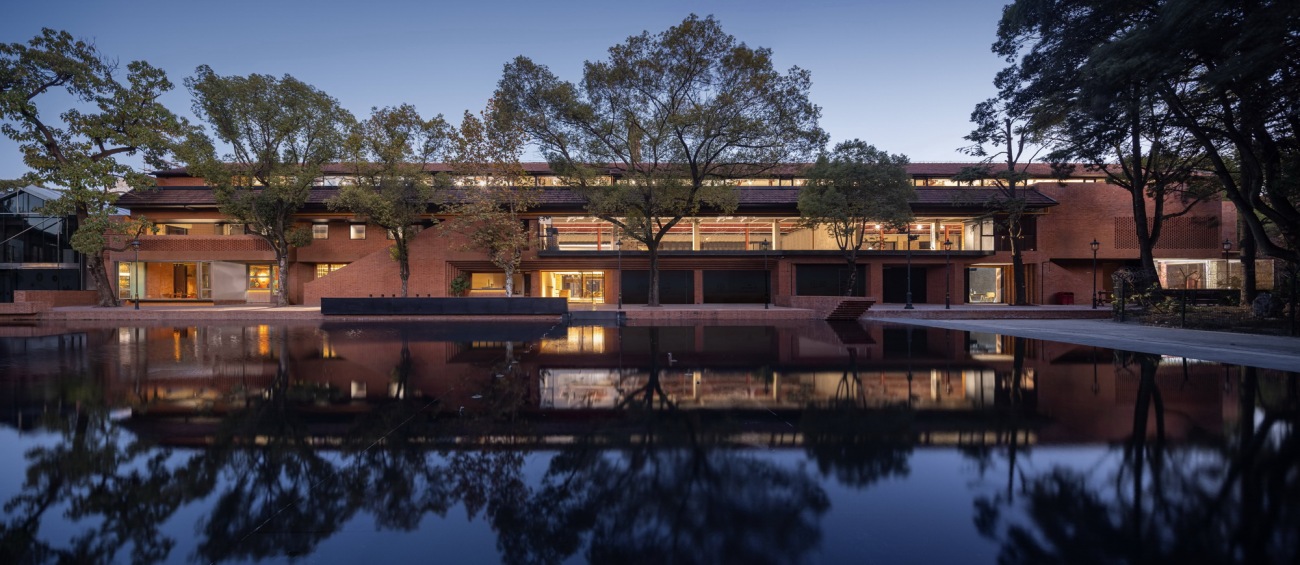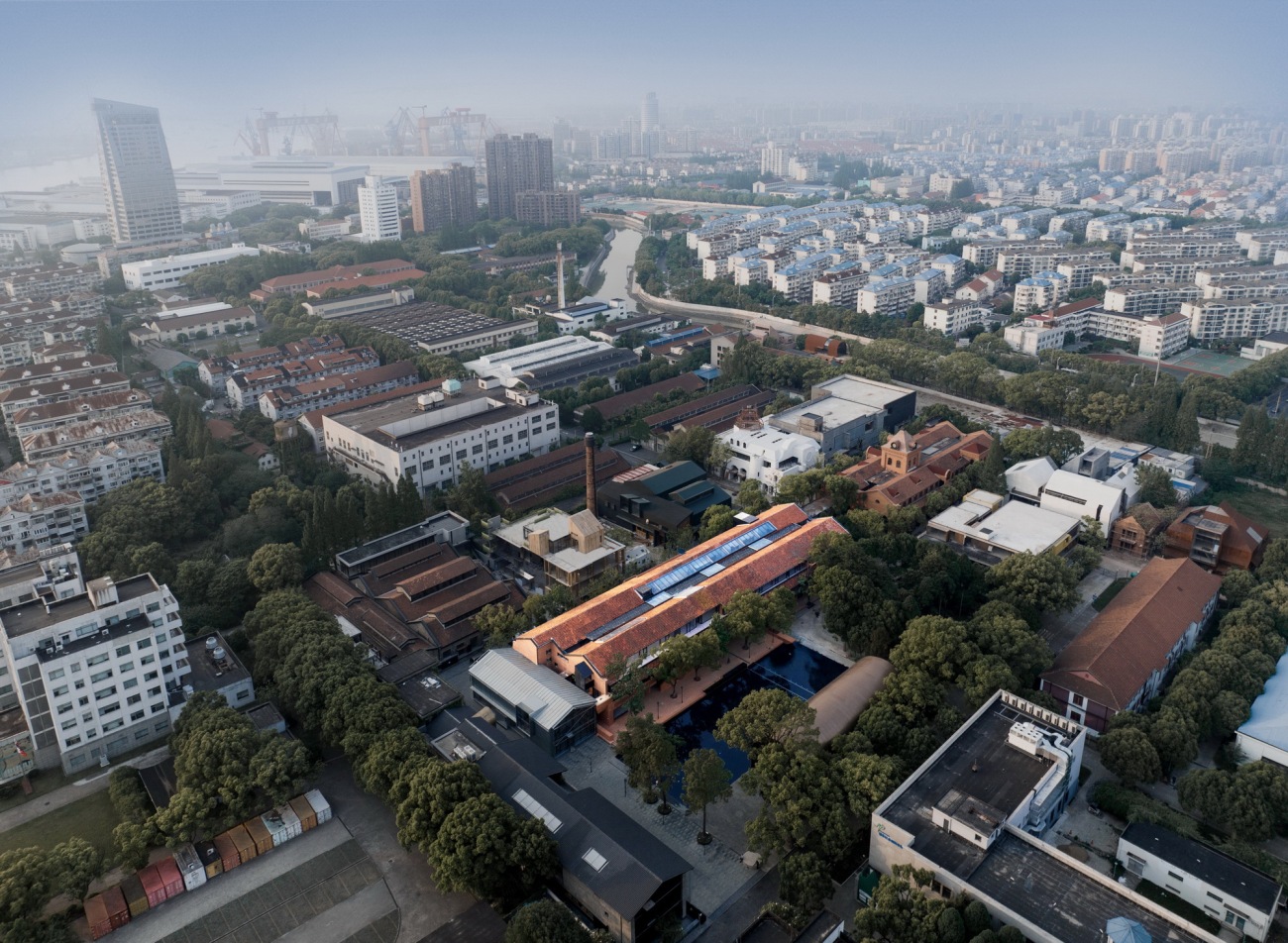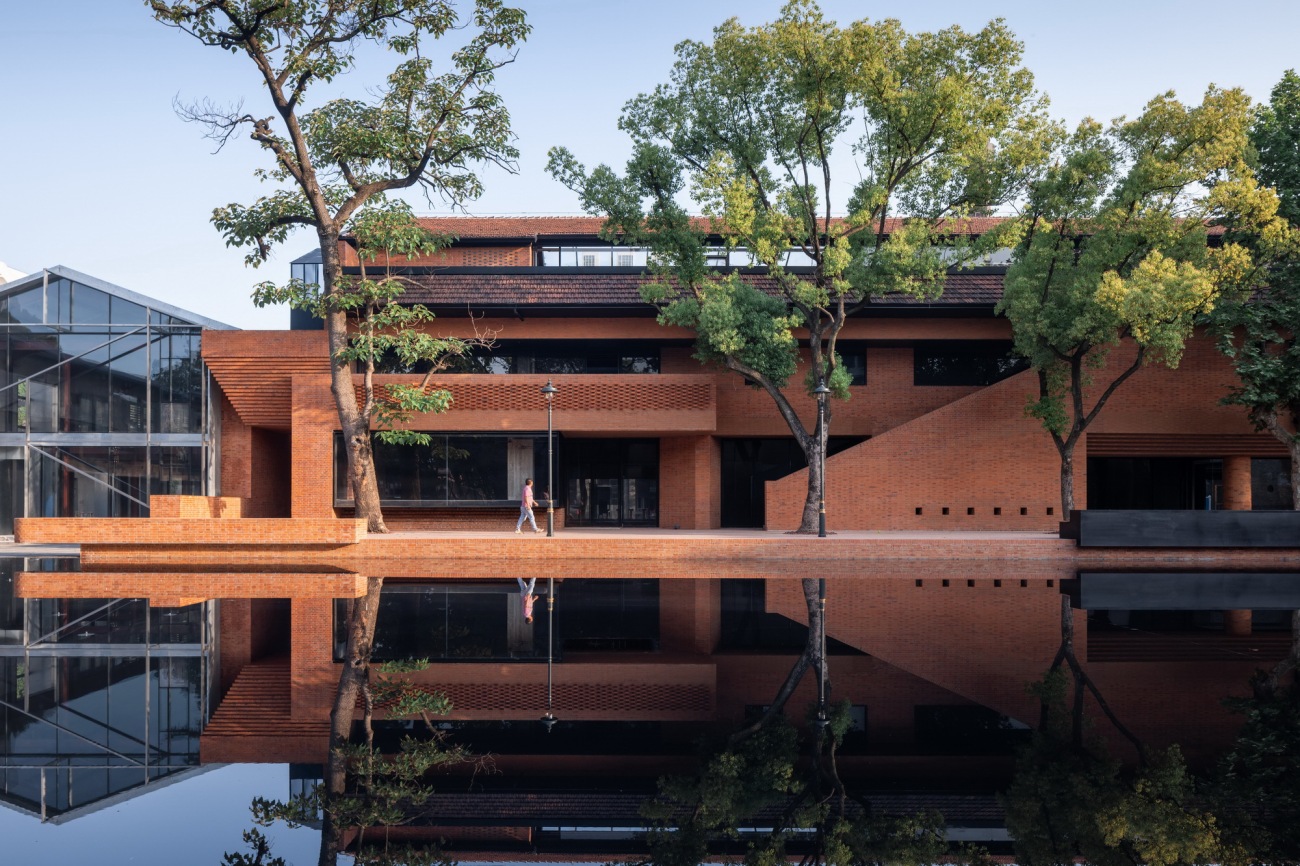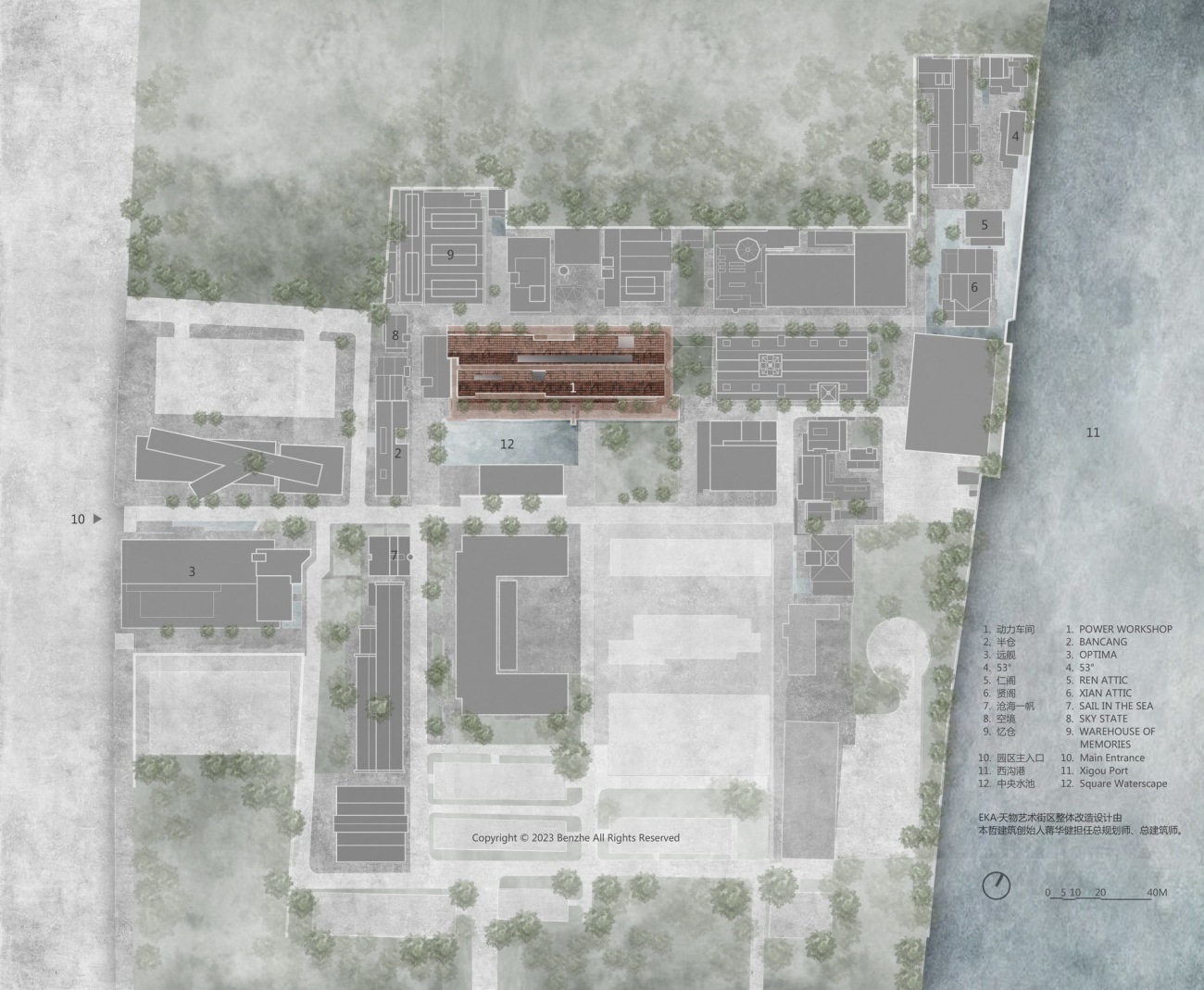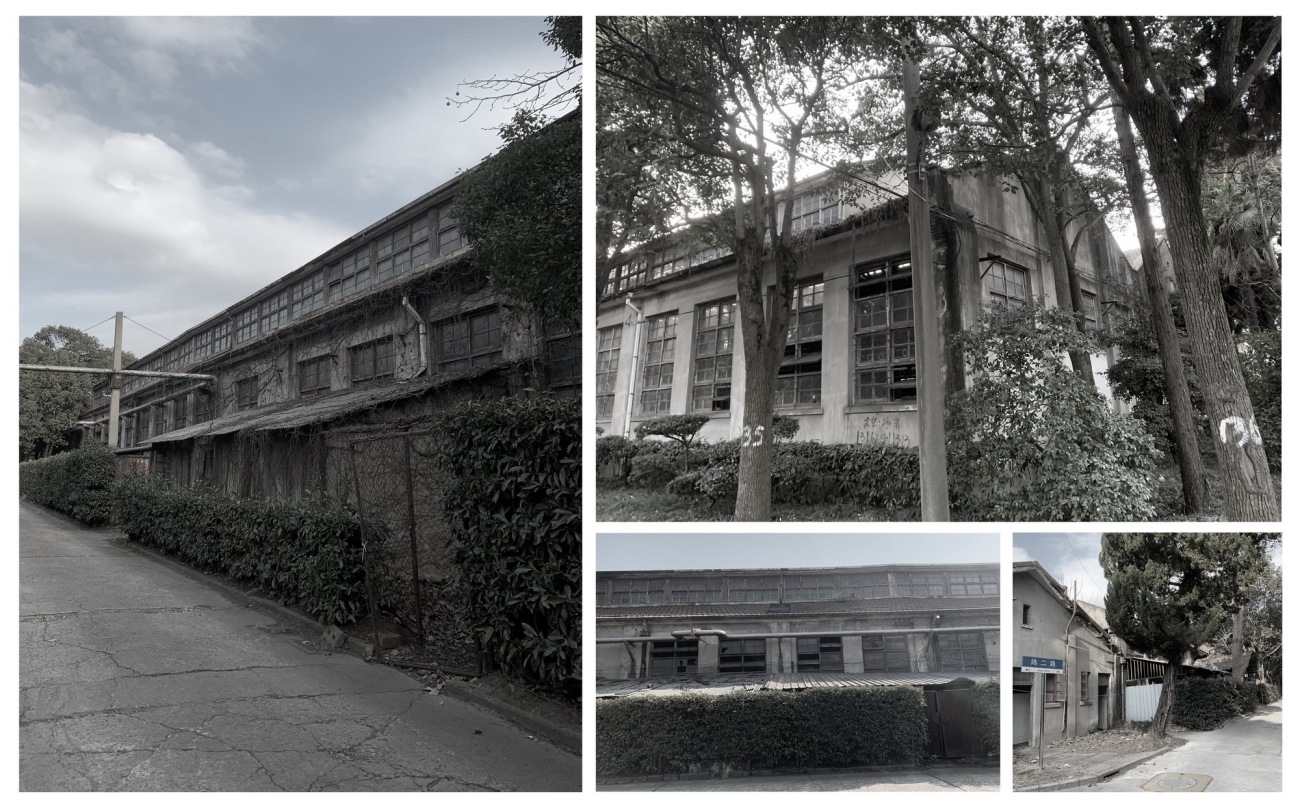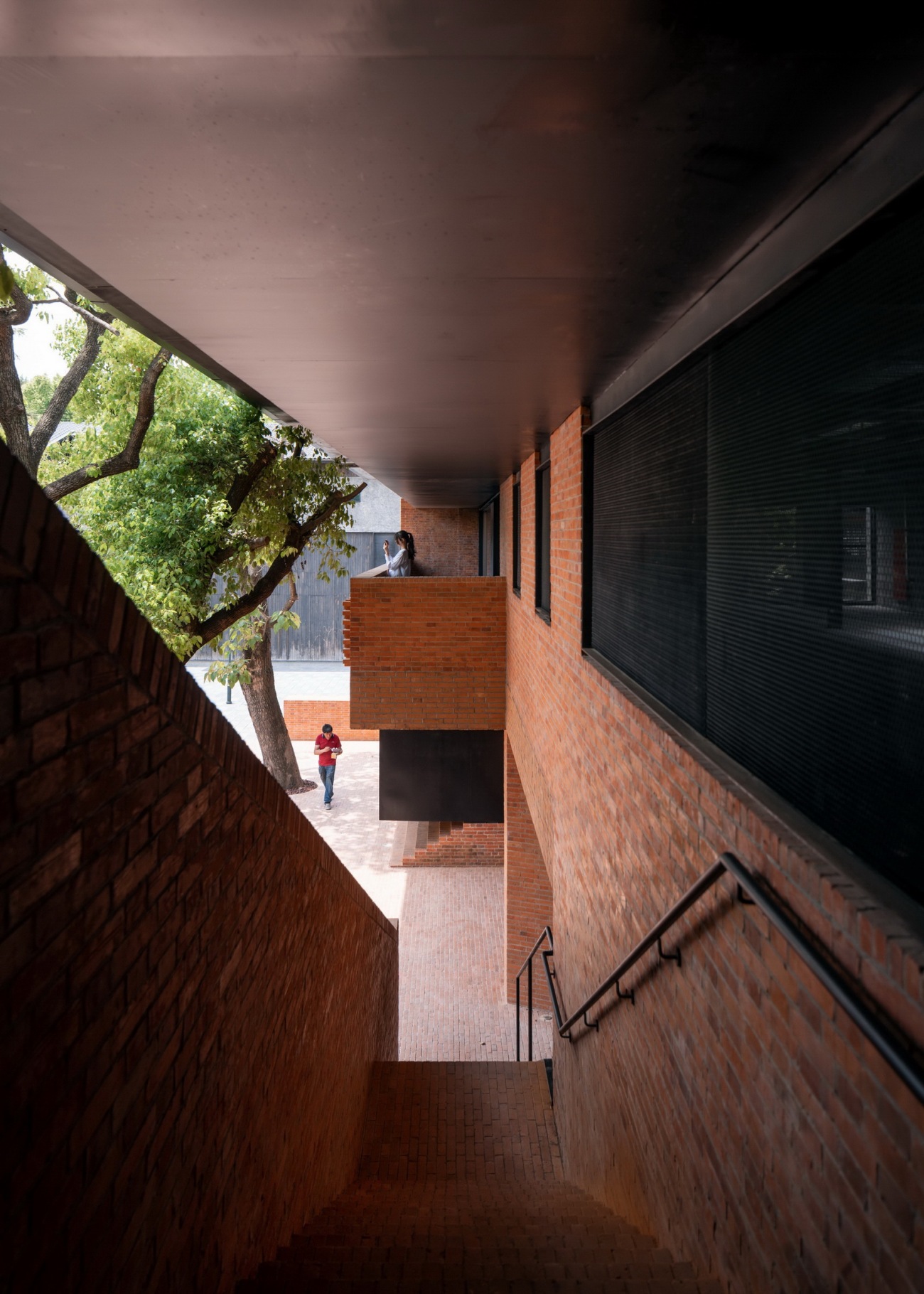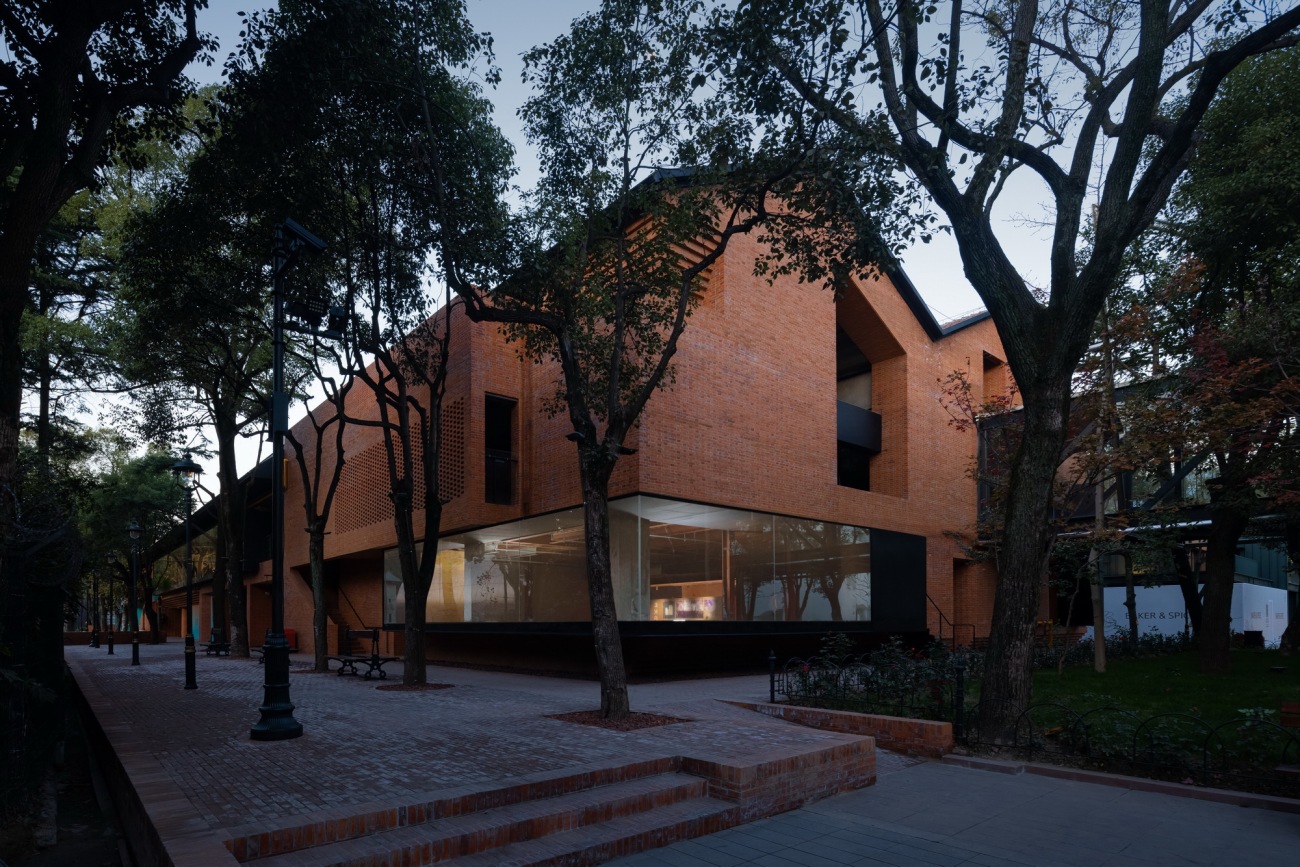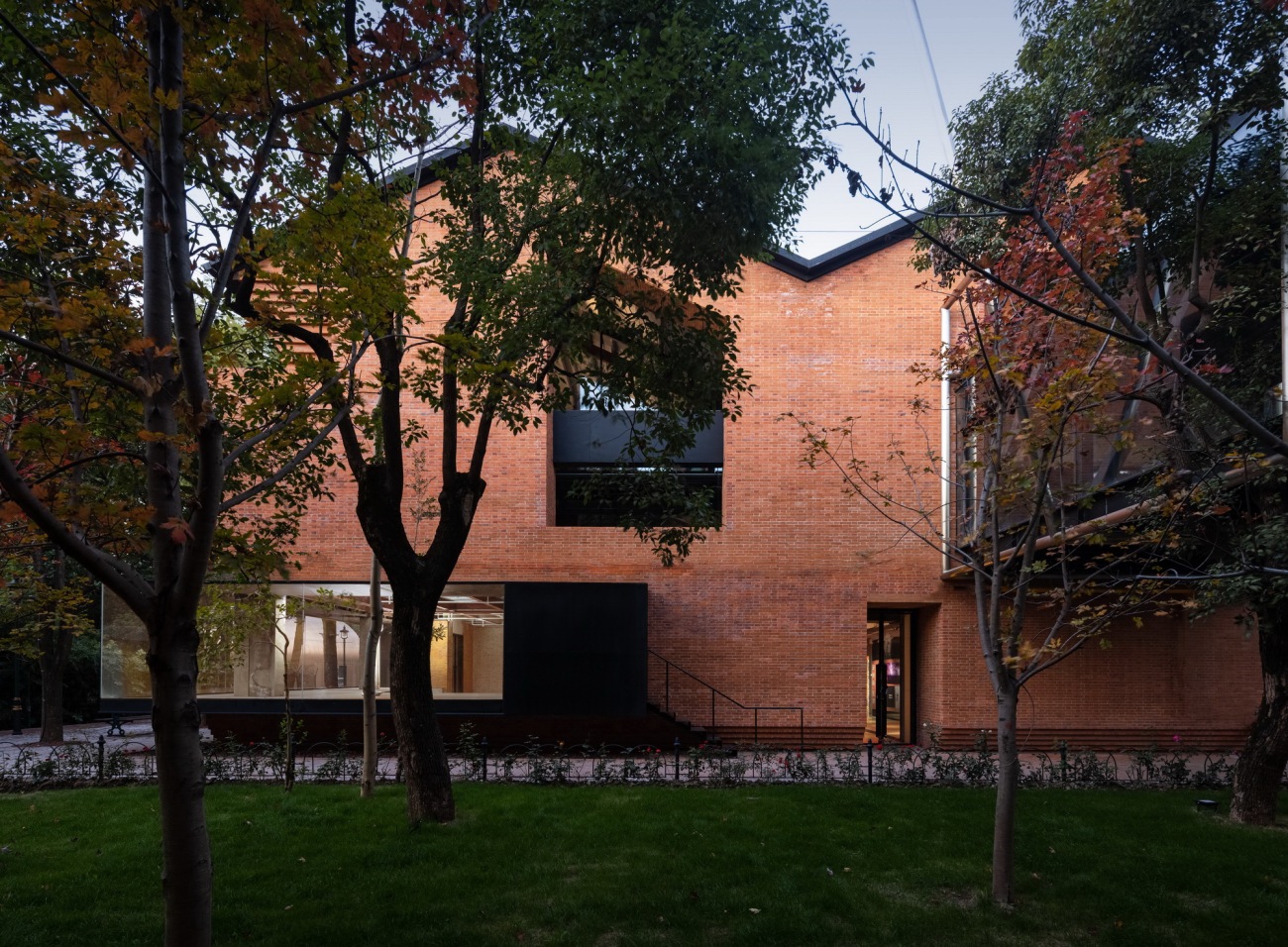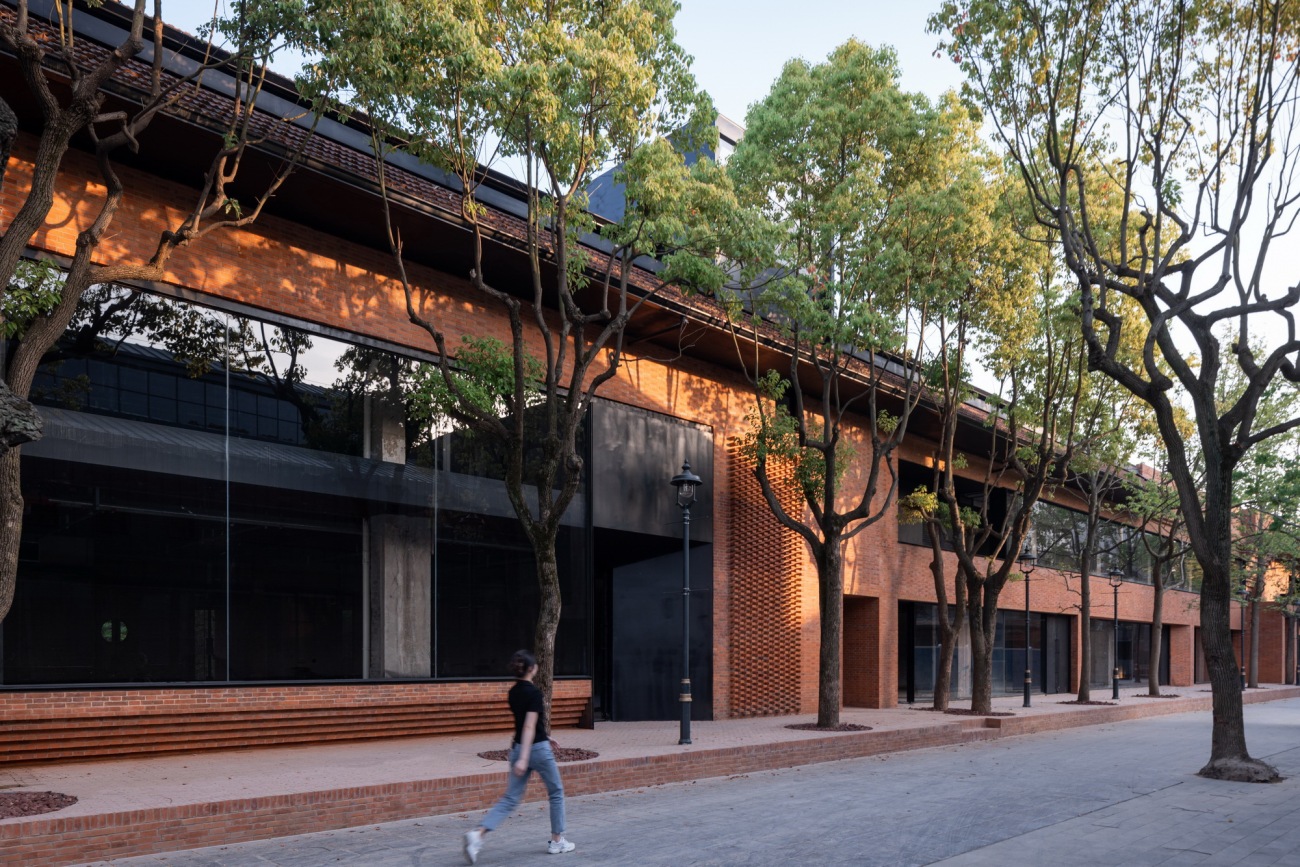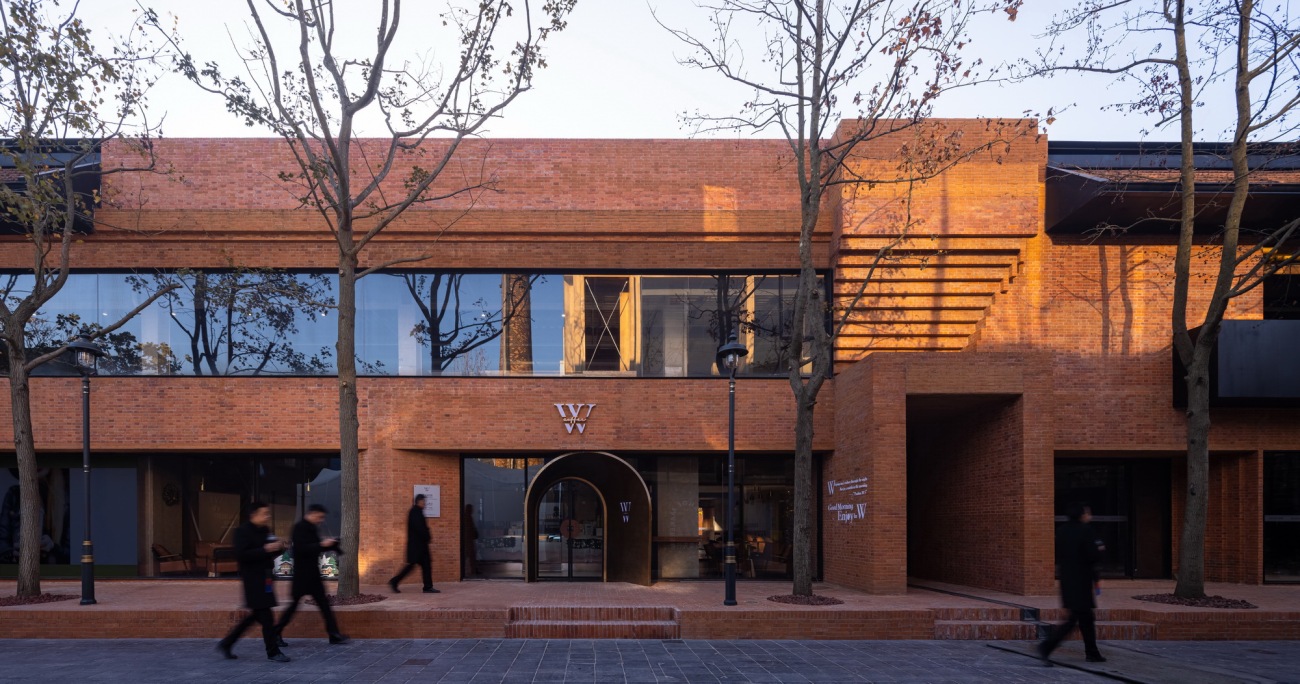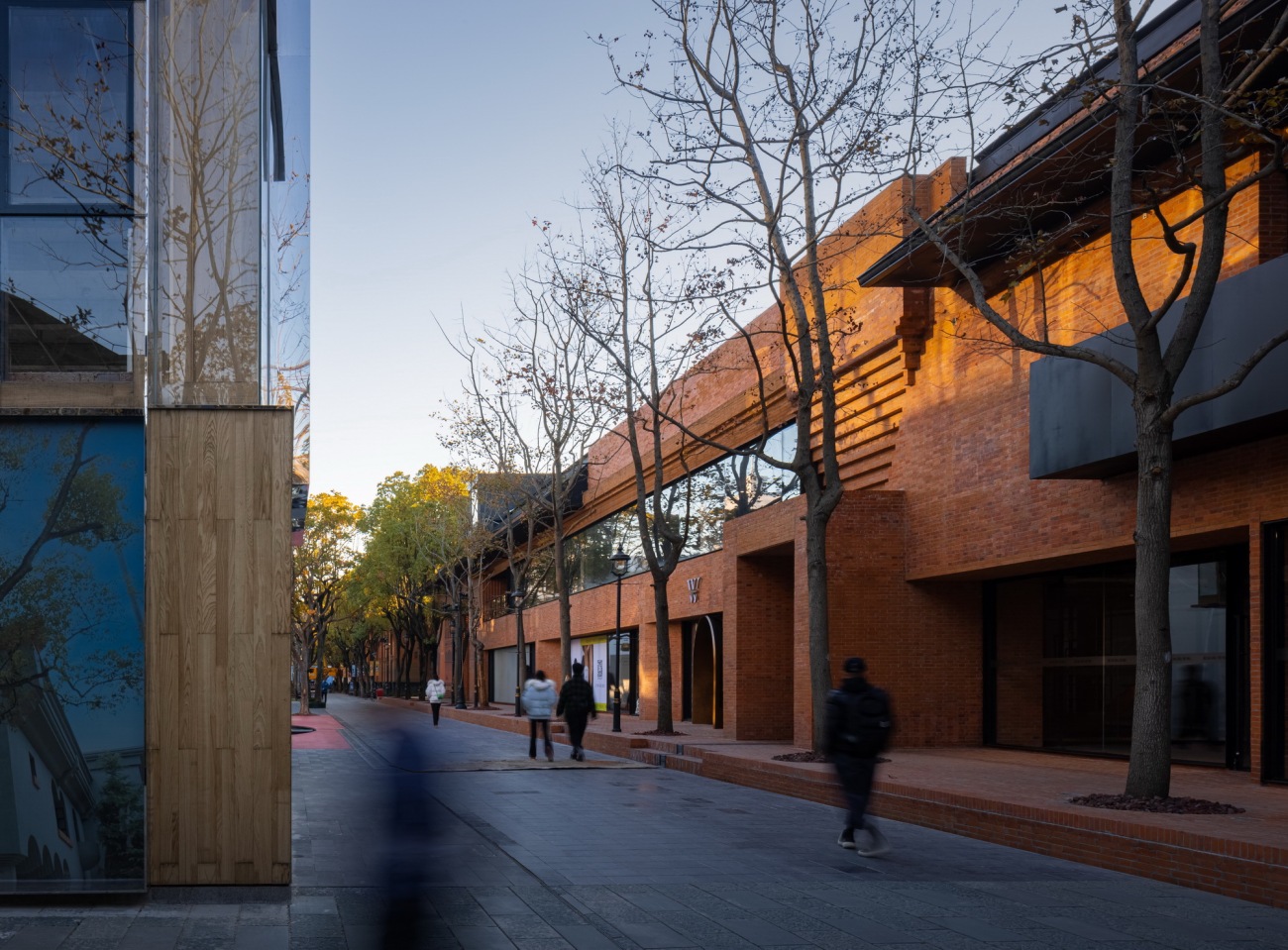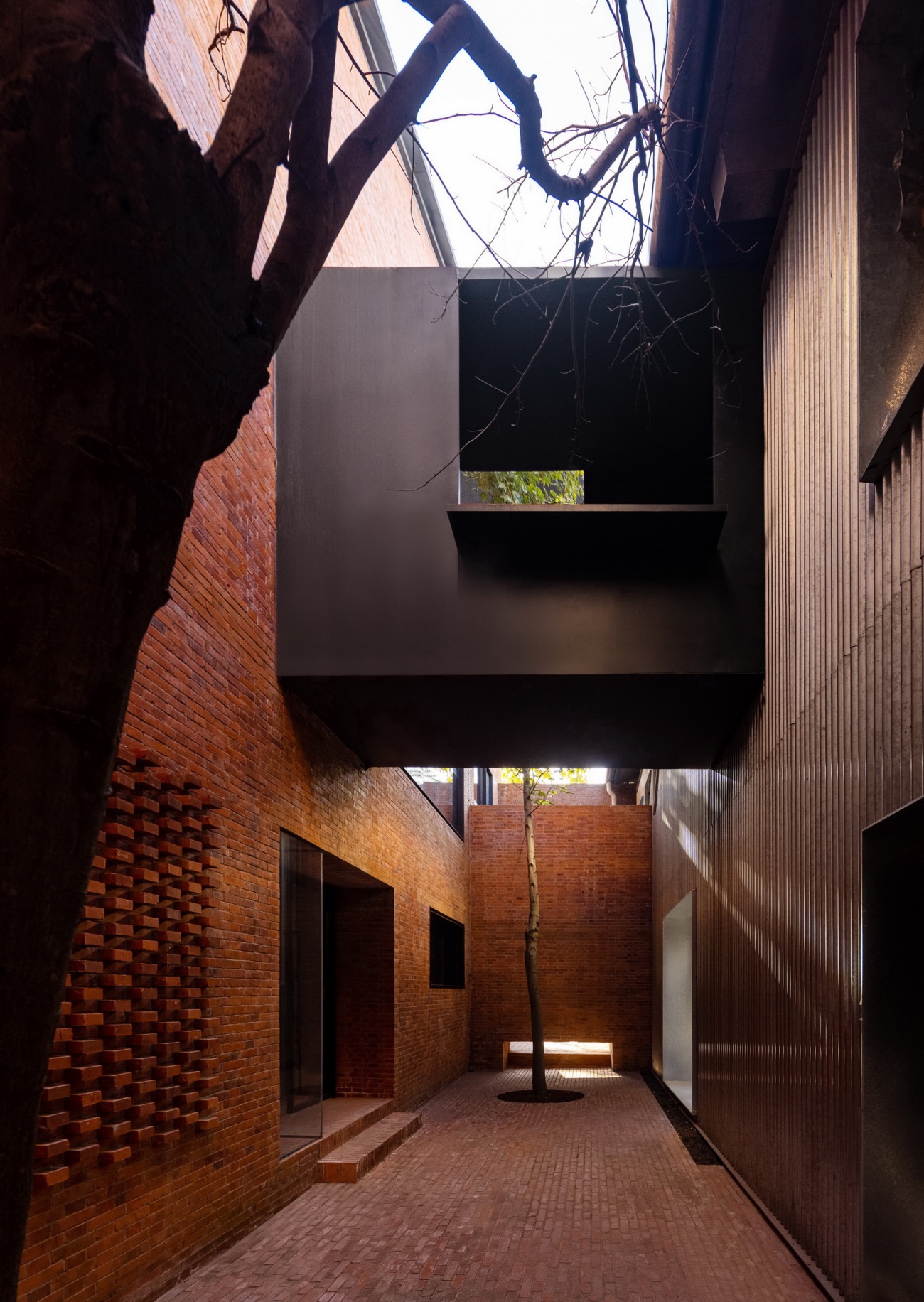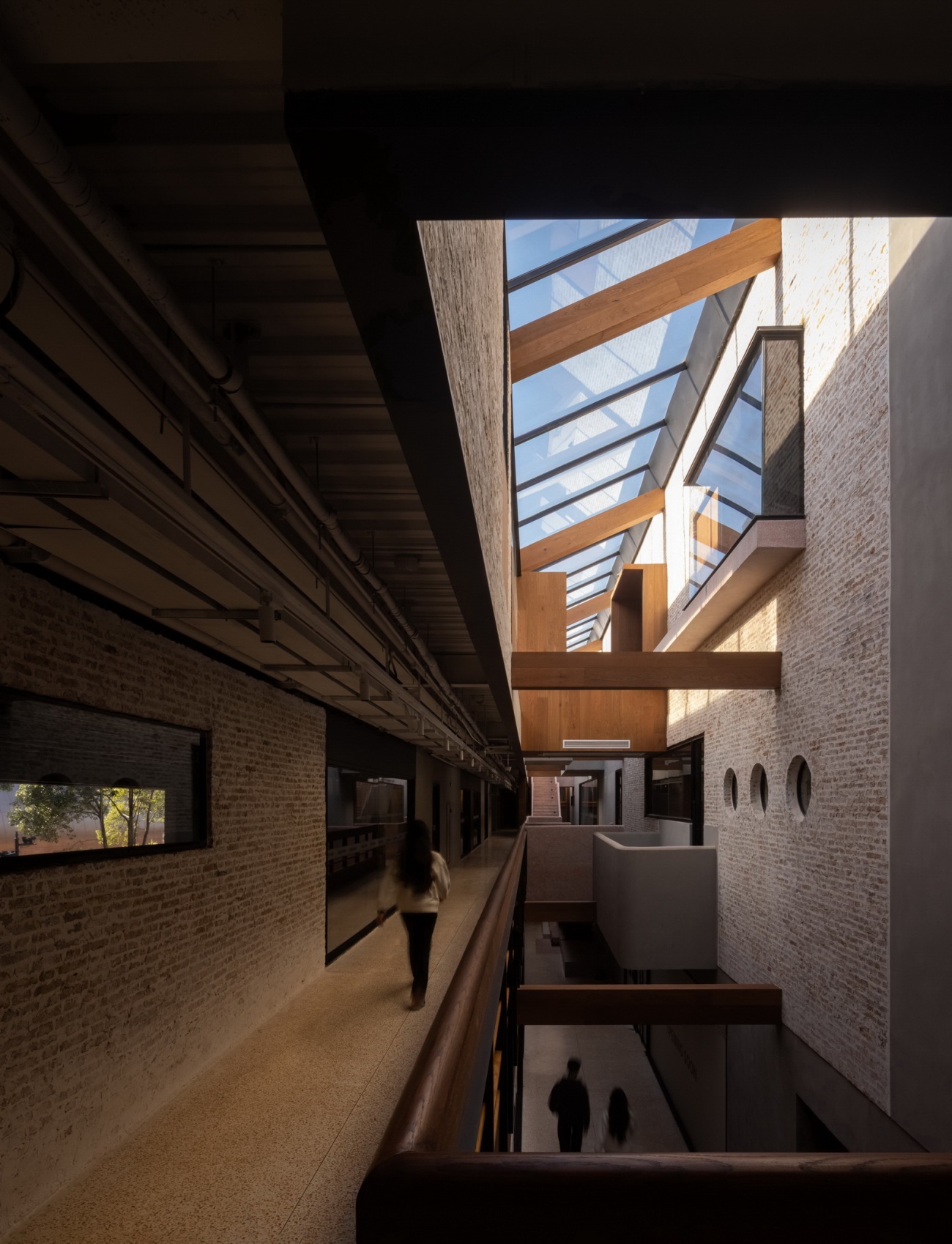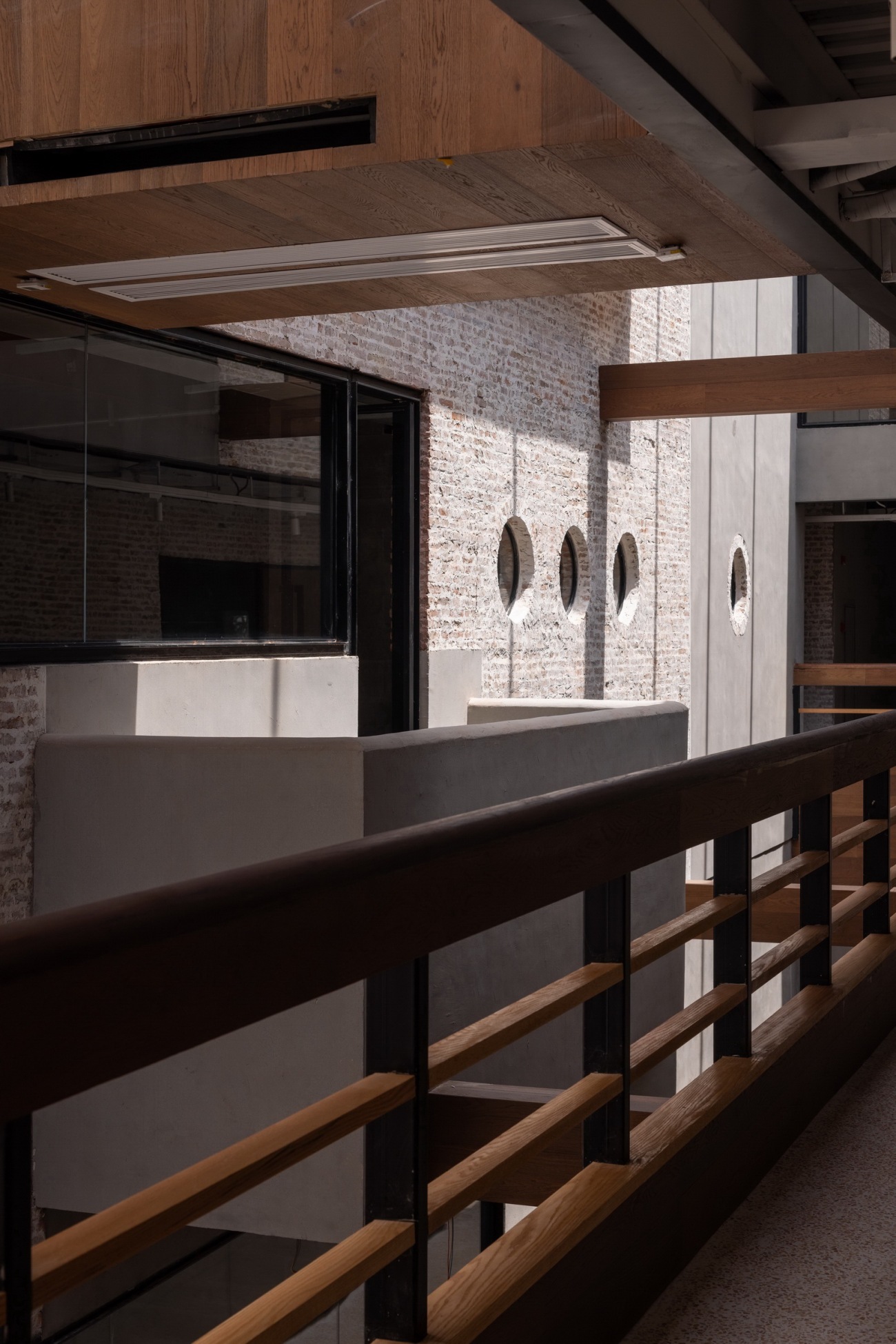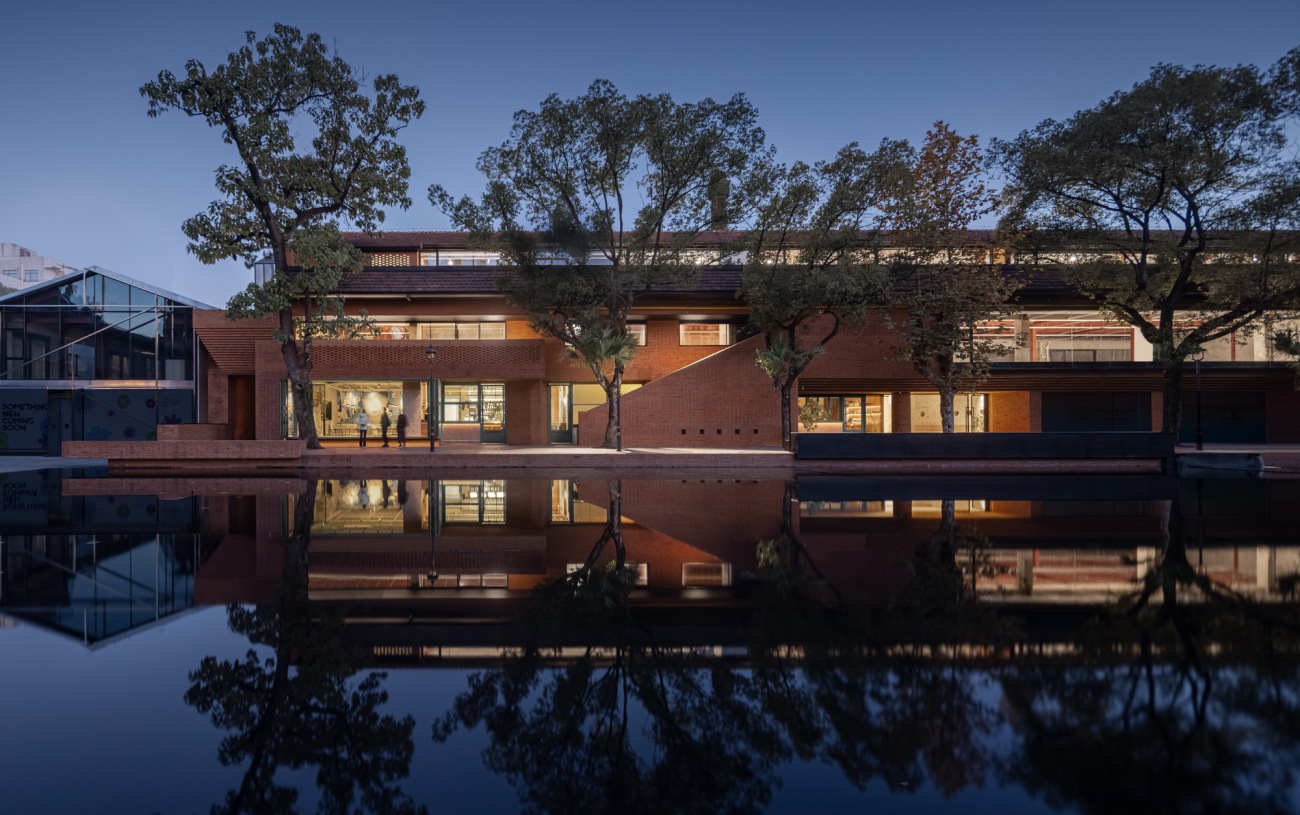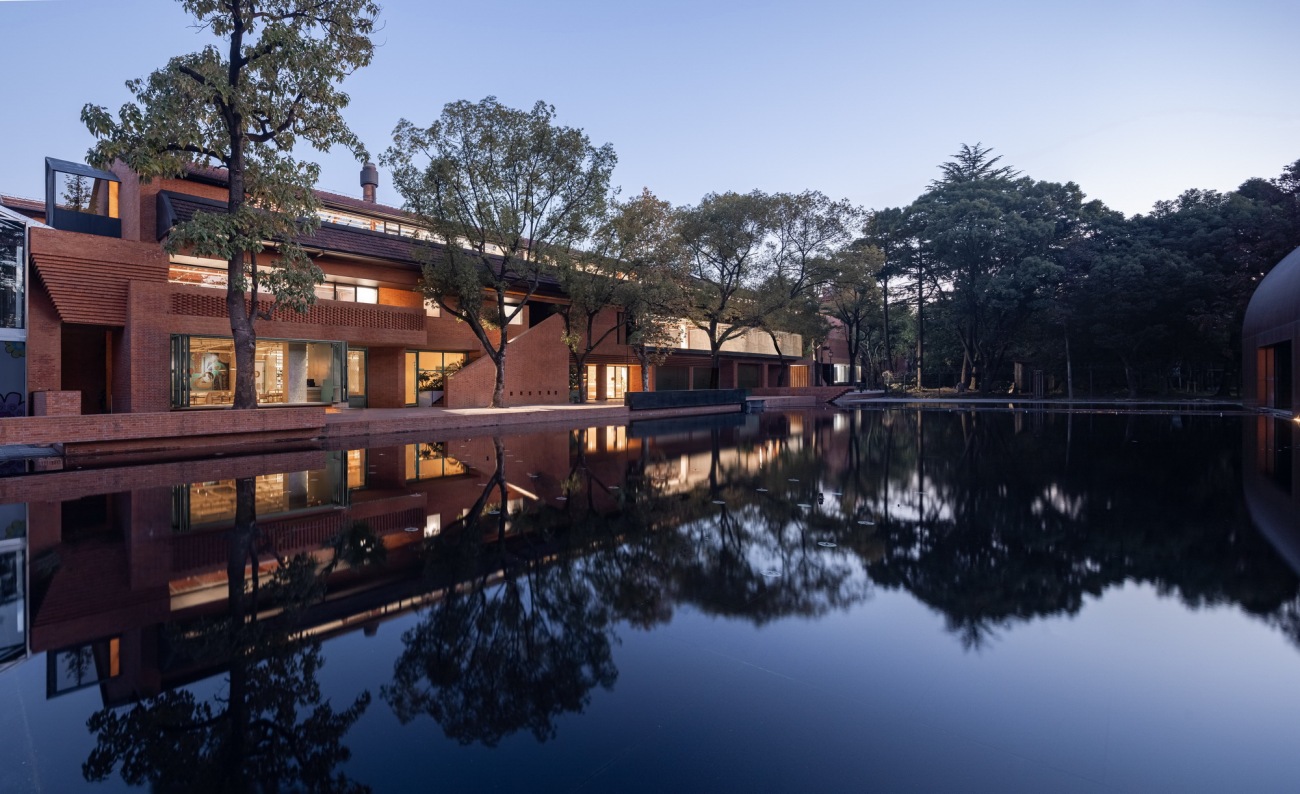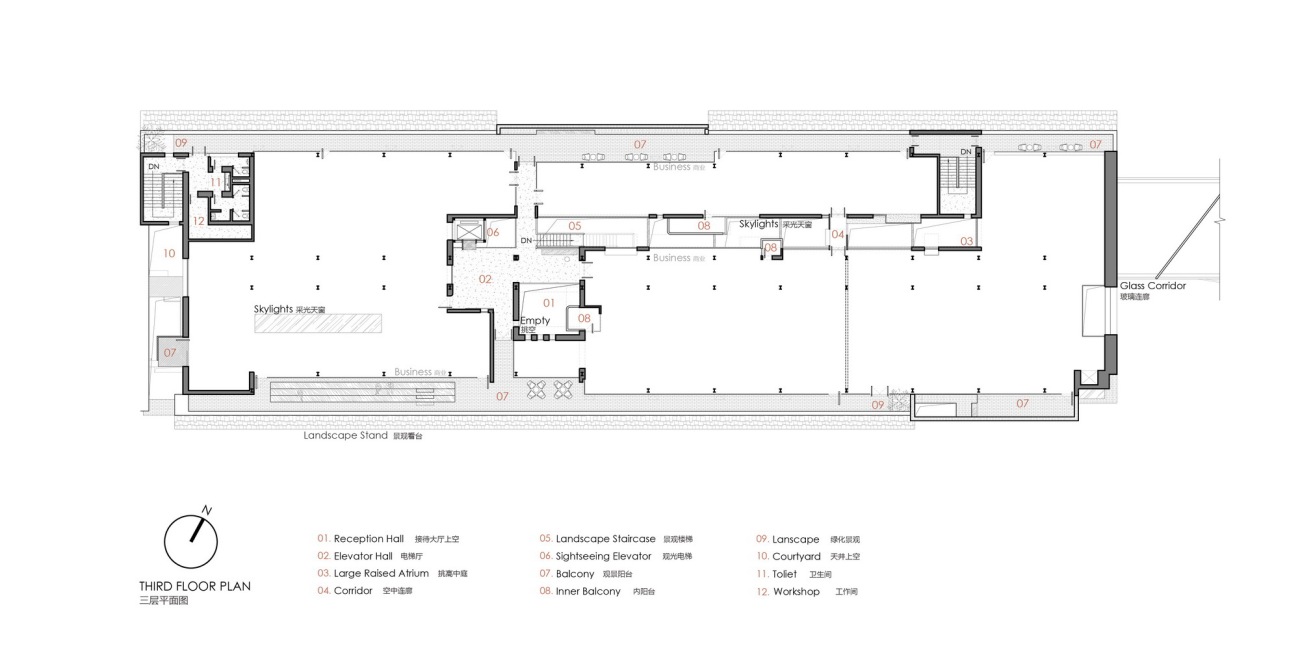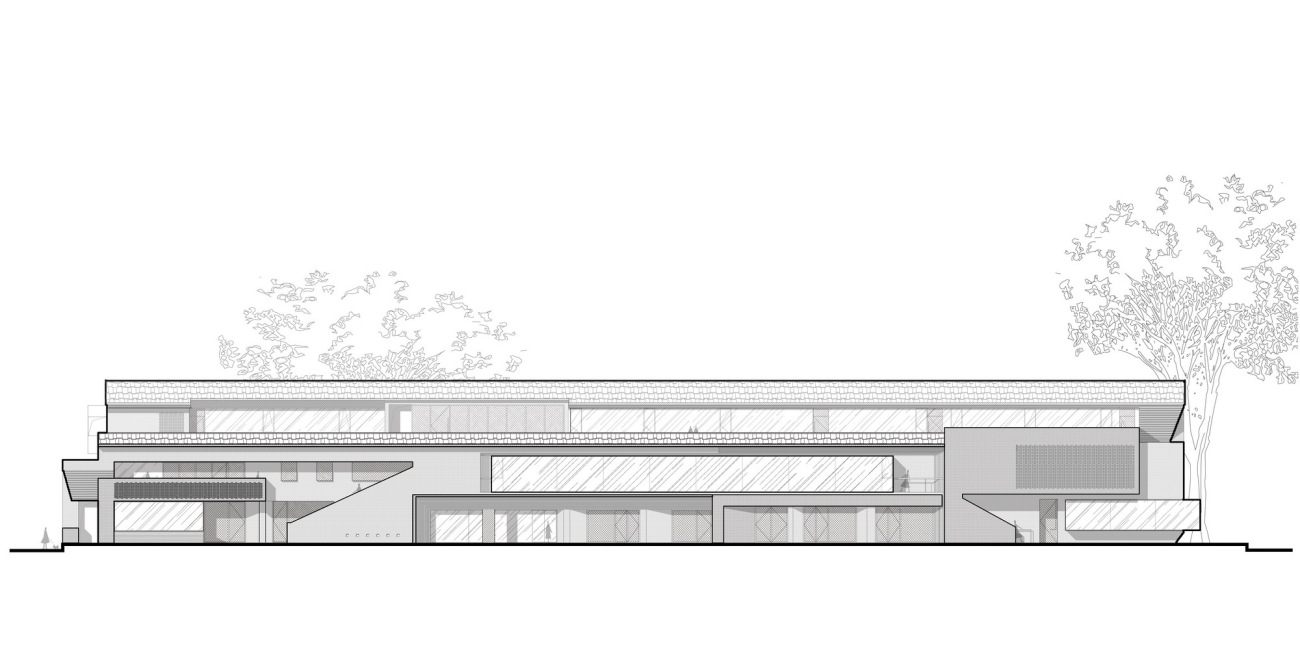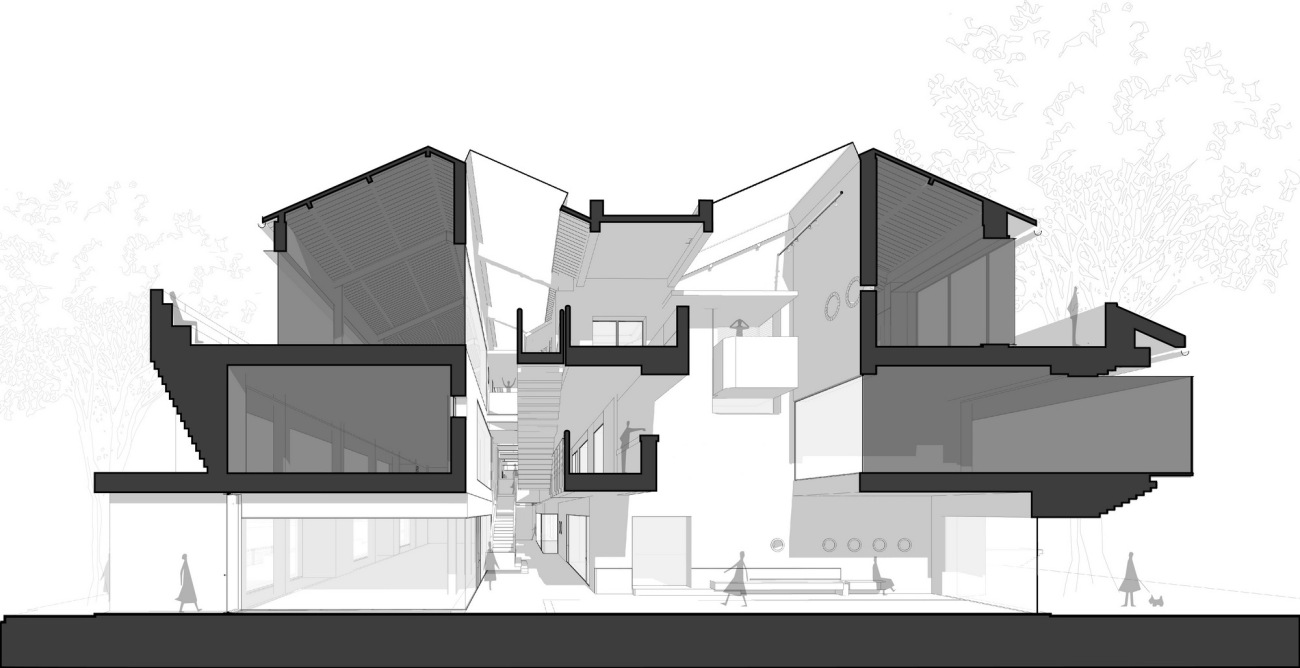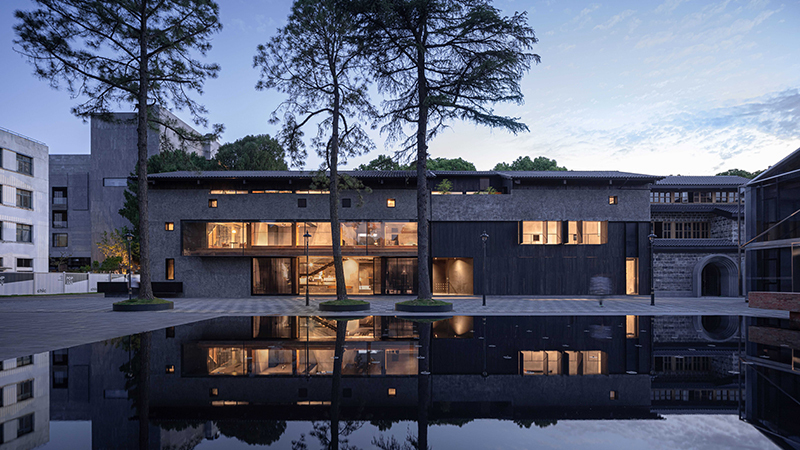「动力车间」位于上海浦东新区金桥板块的EKA•天物艺术街区内,原址为上世纪五六十年代中船航海仪器厂-462栋设备动力车间。受业主方委托对该地区进行整体规划改造设计。作为园区的核心建筑,在更新与活化中,既要尊重历史底蕴,尽可能保留其原本的文化记忆,又要满足当代商业、生活方式等多功能业态的需求,为老建筑注入新活力,展开一场跨越时空的对话。
The Power Workshop is located in the EKA Art District in Jinqiao, Pudong New Area, Shanghai. It is originally the equipment and power workshop, Building 462, China Shipbuilding Naval Instrumentation Factory (CSNIF) in the 1950s and 1960s. Commissioned by the owner, we carried out the overall planning and renovation design of the area. In the renewal and revitalization of the building as the core of the park, it’s necessary not only to respect the history and preserve the original cultural memory as much as possible, but also to meet the needs of contemporary business, lifestyle and other multi-functional business, which means that new vitality was to be injected into the old building, and a dialogue that transcends time and space was to be initiated.
▼「动力车间」整体质朴自然,兼具几分工业风,仿佛跃然水上(冬)
The whole "Power workshop" is a simple and natural, with industrial style in some places, as if it leaps on the water.
「动力车间」保留了原有的双人字梁结构和红瓦坡屋顶,外立面使用大面积清水红砖,风格质朴自然,搭配设计黑色耐候钢板制成的屋檐与窗台,让建筑不失亲和感的同时,重拾了几分原有的工业气息。整个建筑体块通过穿插、叠加、排列、镂空设计等多种方式,营造了移步异景、层次丰富的感官体验。向南临水一面,通过延展清水红砖地面,使露天外摆区仿佛漂浮于水上,模糊了建筑本体与自然的边界,充分展示出本哲建筑的设计理念:关注建筑与人和自然的关系。
The Power Workshop retains the original double-herringbone beam structure and red tiled sloped roof. Isshiki Shimizu red brick was used on the large area of façade, showing a simple and natural style. When it is matched with the design of eaves and window sills made of black weathering steel plates, the building retains a sense of intimacy while recaptures the original industrial flavour. The whole building blocks are interspersed, superimposed, arranged and hollowed out to create a variety of landscapes and rich sensory experience. On the waterfront side to the south, the extension of the red brick floor makes the open swing area seem to float on the water, blurring the boundaries between the building and nature. It fully demonstrates the design concept of Benzhe Architecture Design, that is focusing on the relationship between the building and human beings and nature.
▼「动力车间」整体鸟瞰(夏)
Aerial view of power workshop as a whole
▼商户入驻前「动力车间」正南立面(夏)
The south elevation of the Power Workshop before the commercial tenants moved in
▼建筑南面多层次的视觉体验,细节丰富。(夏)
A angle-inserting staircase on the left side of the south facade provide direct access to the first floor
▼建筑细部及外摆区(夏)
Architectural details and outer swing area
▼EKA·天物艺术街区
EKA Art District
▼建筑原貌
Factory Before Bancang Interventions
底层多为开放式设计,避免二次装修给建筑带来的伤害,让建筑可持续发展。建筑南面左右两侧各外置一处斜插式楼梯,方便向楼上的商户引流,同时令外立面视觉更为丰富。中间部分二楼向外插出贯通式的长条黑色耐候钢框架玻璃窗,无遮挡地向外展示内部的挑高空间,整体通透感十足,兼具工业风;一楼则巧妙运用折线造型手法,为建筑增添优雅与秩序感。
The ground floor is mostly open-plan, which can avoid the damage caused by secondary renovation and allow the building to develop sustainably. On the south side of the building, there is a angle-inserting staircase on the left and right sides, which facilitates the flow to the commercial tenants on the upper floors, and enriches the visual appearance of the facade. In the middle area, the second floor was inserted with long black weathering steel framed glass windows, showing the interior high space without any obstruction, with a sense of transparency and industrial style. For the ground floor, folding line moulding method was cleverly used to add elegance and order to the building.
▼「半仓」、「动力车间」在EKA·天物艺术街区内之间的关系(夏)
The relationship between BANCANG and Power Workshop in the EKA art district
▼南面左侧楼梯与二楼阳台隔空相望,增强空间互动感和趣味性(夏)
The left staircase on the south facade is facing the balcony on the second floor, which enhances the sense of spatial interaction and interest.
▼建筑南面右侧同样外置斜插式楼梯,二楼向内叠级设计小阳台,整体凹凸有致(夏)
The right side of the south facade of the building is also equipped with an external angle-inserting staircase, and the second floor was designed with a small balcony stacked inwards, with an overall concave-convex design.
▼南面右侧二楼外立面使用镂空设计,虚实结合,让空间互相对话(冬 )
For the facade on the second floor on the right side of the south facade, a hollowed-out design that combines the real and the virtual was used, allowing the spaces to dialogue with each other.
▼东南外置楼梯和建筑空间之间的关系(冬)
Relationship between the southeast external staircase and the architectural space
东南拐角处插入一钢框玻璃盒子,引入自然光线。同时在南面山墙中部做切口打开,设置悬空阳台,形成虚实对比,山墙下部采用向内叠级,玻璃盒子好似浮在空中,造型别致,为老建筑注入时代脉搏。
A steel-framed glass box was inserted at the southeast corner to introduce natural light. At the same time, the mountain wall on the south face was cut to open in the middle, and a suspended balcony was set up, forming a contrast between reality and reality. In the lower part of the mountain wall, inward stacking was used. The glass box seems to be floating in the air. The chic modelling injected the pulse of the times into the old building.
▼「动力车间」东南角(冬)
Southeast of Power Workshop
▼东南角悬浮的玻璃盒子(冬)
The suspended glass box in the southeast corner
▼隐逸在树林中的「动力车间」(冬)
Power workshop hidden in the woods
▼东南拐角玻璃盒子细部(夏)
Detail of a glass box in the southeast corner
建筑北立面朝向主街,采用现代简约风格,通过大面积的平面长条玻璃窗与插出的条状黑色耐候钢板阳台,塑造了流畅的整体视觉体验。同时,局部采用的连续叠级式造型、玻璃砖与红砖的交叉排列,以及别具匠心的钢网面小阳台,让北立面层次更为丰富,造型更为独特。
For the north facade of the building facing the main street, a modern minimalist style was adopted. A smooth overall visual experience was created with the large flat long glass windows and inserted strips of black weathering steel plate balconies. At the same time, continuous stacked-level modelling, the cross-arrangement of glass bricks and red bricks, and the ingenious steel mesh-faced small balconies were adopted in local places, making the north elevation more rich in levels and unique in shape.
▼「动力车间」与东面玻璃连廊贯通(夏)
Corridor connecting the Power Workshop on the east side
▼开放式的底层设计(夏)
Open ground floor design
▼EKA·天物艺术街区中的「动力车间」(冬)
Power Workshop in EKA Art District
▼清晨独有的光影韵味(冬)
The unique light and shadow in the early morning
▼北立面局部(夏)
Local north elevation
▼「动力车间」北立面建筑细节(夏)
Architectural detail of the north elevation of the Power Workshop
为了提升建筑与整个艺术街区的互动体验,「动力车间」在东西两侧均设置了空中连廊,人们可以直接由此进入临近的建筑空间。其中,西面的连廊位于建筑西端的庭院之中,采用黑色耐候钢板制成,左右各开方形窗,仿佛一个空中阳台,与建筑本身的红砖形成冷与暖、现代与传统的视觉对比。东面的连廊因穿梭在树木掩映的绿荫之中,特意采用钢构透明玻璃材质,让建筑与人、自然融为一体。
In order to enhance the interaction between the building and the whole art district, sky corridors were set on the east and west sides of the Power Workshop, which allow people to enter the neighbouring spaces directly. The west gallery is located in the courtyard at the west end of the building, and is made of black weathering steel plates with square windows on the left and right, resembling a balcony in the sky, forming a visual contrast between cold and warm, modern and traditional, with the red bricks of the building itself. The eastern corridor is made of steel and transparent glass because it passes through the shade of the trees, allowing the building to form a whole with people and nature.
▼合院里的连廊(冬)
Connecting Corridor in the Courtyard
▼合院中的一棵树(冬)
A tree in a courtyard
建筑室内设有挑高中庭,老木梁结构被暴露,增加了多个高低阳台,错落有致,阳光透过狭长天窗 ,洒进室内,明亮、通透,过去与当下在这里交错重叠。旧墙面开有连续圆形窗孔,就像船舱的舷窗 ,引导人们一探究竟。岁月留下的斑驳粗犷的旧红砖墙与石灰肌理在光影的变化中显现出不同时期的历史印记。
The interior of the building has a raised atrium, where the old wooden beams are exposed, and a number of balconies of different heights are added in a staggered manner. The sunlight shines into the interior through the narrow skylights, making it bright and transparent, where the past and the present are overlapping. The old walls have continuous circular windows, like the portholes of a ship's cabin, which lead people to explore the interior. The old red brick walls and lime texture left by the years show the history of different periods through the change of light and shadow.
▼阳光从天窗洒进,明亮、温暖。
Sunlight shines in through the skylight, which is bright and warm.
▼水磨石楼梯贯穿整个中庭
Terrazzo staircase runs through the entire atrium
▼在中庭连廊上穿行
Running through the atrium gallery
▼建筑室内细部
Interior details of the building
室内主要以水磨石、拼色原木、红砖为肌理,与外建筑表皮相呼应,暖色系的水磨石楼梯在建筑空间中穿行,迂回灵动。原木装饰直达电梯、走廊、连廊与温润的水磨石,古朴又温暖,身处室内亦可感受自然的律动。
The main texture of the interior is terrazzo, colour-matched logs and red bricks, echoing the outer skin of the building. The warm terrazzo staircases run through the architectural space, meandering and moving. The warm tone terrazzo staircase runs through the architectural space circuitously and dynamically. The log decoration covers the lift, passage, connecting corridor and warm terrazzo, allowing people to feel the simplicity, unsophistication and warmth, and the rhythm of nature indoors.
▼温暖的水磨石楼梯在室内迂回穿梭
A warm terrazzo staircase meanders in the interior space
▼水磨石楼梯细部
Details of the terrazzo stair
▼透过舷窗,一探究竟
Taking a peek through the porthole
▼拼色原木外观的直达电梯
Direct lift with patchwork log look
▼建筑、人与自然之间的对话
Dialogue between the building, human and nature
整个空间动静相宜,温润有力,故名「动力车间」。
The whole space is both dynamic and static, and warm and powerful. That’s why it is called "Power Workshop".
▼冬季时节的「动力车间」南主立面(冬)
The south main elevation of Power Workshop in winter
▼破晓时分的「动力车间」与中央水池(冬)
The "Power Workshop" and the central pool at dawn.
▼一层平面图
One-level floor plan
▼二层平面图
Two-level floor plan
▼三层平面图
Three-level floor plan
▼北立面图
North facade
▼南立面图
South facade
▼东立面图
East facade
▼剖面图
Section
▼剖面图
Section
▼剖面图
Section
项目名称:动力车间
项目地点:中国上海市浦东新区金桥路535号(EKA·天物)
建筑/室内/景观设计:本哲建筑
主创建筑师:蒋华健
设计团队:姚瑞艮 林桐
建筑面积:5280 m²
占地面积:1920㎡
设计时间:2022年2月-2022年9月
竣工时间:2023年8月
公司网站:www.benzhedesign.com
公司邮箱:bd@benzhedesign.com
业主方:上海嘉韵投资管理发展有限公司
结构设计:上海同宴土木工程咨询有限公司
摄影:苏圣亮 王策
Project name: Power Workshop
Location: 535 Jinqiao Road, Pudong New Area, Shanghai, China (EKA)
Building/interior/landscape designer: Benzhe Architecture Design
Senior architect: Jiang Huajian
Design team: Yao Ruigen, Lin Tong
Building area: 5280 m²
Floor space: 1920 m²
Design time: February 2022-September 2022
Completion time: August 2023
Company website: www.benzhedesign.com
Company Email: bd@benzhedesign.com
Owner: Shanghai Jiayun Investment Management Development Co.,Ltd
Structure Designer: Shanghai Tongyan Civil Engineering Consulting Co.,Ltd
Photography: Su Shengliang, Wang Ce
更新日期:2024-04-08 15:34:30
非常感谢 本哲建筑 带来的精彩项目, 查阅更多Appreciations towards Benzhe Architecture for sharing wonderful work on hhlloo. Click to see more works!
